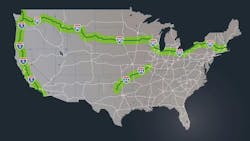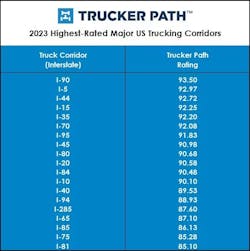Driver and fuel data reveal the best freight corridors nationwide
The northernmost east-west and westernmost north-south freight corridors are among the most friendly paths for truck drivers, according to new rankings released by Trucker Path, which focuses on driver, broker, and fleet management solutions.
Based on parking availability, truck stop ratings, and fuel prices, the ratings highlighted Interstate 90, I-5, and I-44 as the most friendly to drivers. I-90 runs from Seattle to Boston, I-5 extends up and down the West Coast from the Mexican border to Canada, and I-44 runs from northern Texas to St. Louis.
"We hope this report is helpful for drivers when considering the loads they move and/or the lanes they want to run," said Chris Oliver, chief marketing officer for Trucker Path. "Our primary mission at Trucker Path is to help make 'a day in the life' of every trucker a little easier and more comfortable while also giving them valuable tools to help them be safe and cost-efficient as a business."
How Trucker Path ranked the interstates
I-90, I-5, and I-44 were all rated in the 90s based on Trucker Path’s 100-point system. The company rated I-90 at 93.5, I-5 at 92.97, and I-44 at 92.72. Additionally, 19 other highways ranked above 85.
Trucker Path based the points on user ratings and reviews in its app. "We get in excess of 20 million inputs (ratings & reviews) from truckers every month," Oliver stated.
Trucker Path's app gathered parking availability and truck stop ratings, while fuel price data came directly from truck stops, fueling locations, and ProMiles. Each category was weighted differently in the rankings based on its importance to the trucking industry.
"We selected Parking Availability and Fuel Prices because they are 2 of the most impactful factors to a driver/owner-operator's daily life and their businesses," Oliver explained. "Truck Stop/POI ratings were included because it’s an excellent measure of the overall trucker experience at the places they stop when traveling each corridor."
Due to parking’s importance, safe, accessible space availability was weighted at 45% in Trucker Path’s interstate rankings. Although truck parking has improved from 2021-2023, according to the company, it also found that across the country, 9% of areas had no spaces available during the day in 2023, and 26% had no spaces available at night.
While Congress did introduce a bill, the Truck Parking Safety Improvement Act, to assist with the issue, Oliver did not anticipate that truck parking would be an easily solved problem.
See also: Outpost raises $12.5 million to target the nationwide truck parking shortage
Parking “is not something that gets fixed quickly and easily,” Oliver told FleetOwner earlier this year. “I think the raised awareness will certainly contribute to it not getting worse, but I don't expect it to magically improve and become amazing this year.”
Meanwhile, truck stop amenities were weighted at 27.5% in Trucker Path's ratings. In another study from the organization, which polled over 500 drivers, the top five amenities for truck stops include abundant parking (86.3%), clean showers (67.5%), on-site restaurants (46.6%), a good healthy/fresh food selection (40.7%), and 24/7 truck maintenance services (29.2%).
Finally, Trucker Path weighted average fuel prices at 27.5% in their highway corridor rankings. Although diesel fuel costs have been decreasing across the country since mid-February, according to the U.S. Energy Information Administration, the national average is still $3.726 per gallon. This price can stack up quickly, especially when fuel costs are higher than this average along the East Coast ($3.853 per gallon) and the West Coast ($4.429 per gallon including California and $3.960 without).
About the Author
Alex Keenan
Alex Keenan has been associate editor for Endeavor's Commercial Vehicle Group, which includes FleetOwner magazine, since 2022. She has written on a variety of topics for the past several years and recently joined the transportation industry, reviewing content covering technician challenges and breaking industry news. She holds a bachelor's degree in English from Colorado State University in Fort Collins, Colorado.

